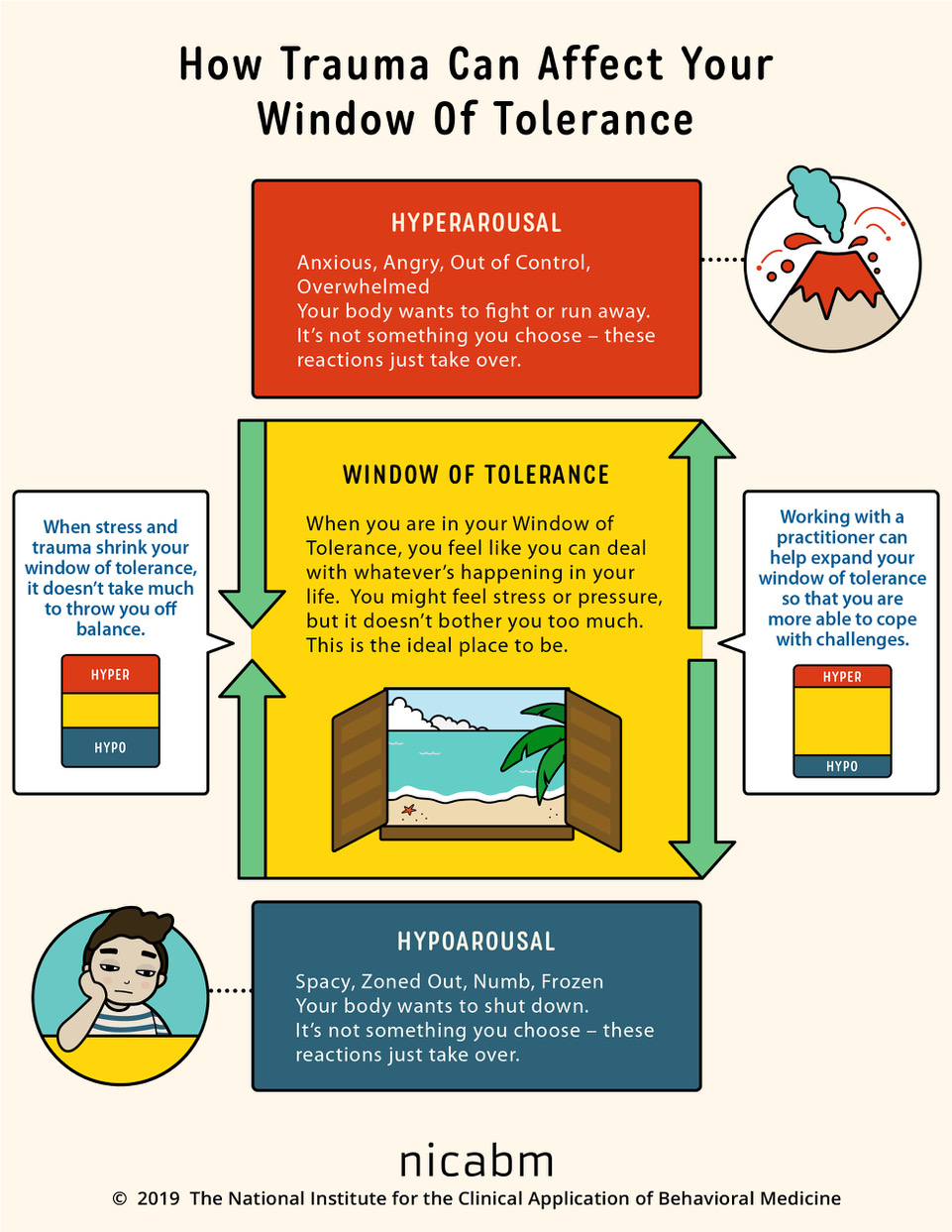
Tips & Tools
Managing your anxiety
Window of Tolerance – How it Can Help… And Hinder Us

Written by: Joelle Anderson, MA, RP, CCC
Have you noticed this – throughout any given hour, day, or week, our emotions fluctuate quite a bit? That’s normal, and common. And, on days where we feel a lot, we might also have periods in between the “big” emotions where we feel zoned out, numb, tired, or shut down.
For those overcoming anxiety (or other anxiety-related disorders like trauma, obsessive compulsive disorder, etc.), the swings between “big” emotion and feeling knocked out may be even more pronounced.
So what’s going on there? Dr. Siegel (1999) developed a model to explain this fluctuation. He called it Window of Tolerance. His model is outlined in the image below, from the National Institute for the Clinical Application of Behavioral Medicine (NICABM; 2019).

Essentially, Siegel’s (1999) model suggests we all have an optimal amount of emotion that we can tolerate with reasonable skillfulness. This is our Window of Tolerance. When we feel more emotion than is tolerable for us, it is called “hyperarousal”. This feels like too much emotion and may be overwhelming and/or difficult to control (think panic attacks, uncontrollable crying or sadness, or explosive anger).
At the other extreme, our body may go into periods of “shut down” or feeling too little. This is called “hypoarousal”. It commonly occurs after periods of being hyperarousal because the body eventually engages this as a “shut down” response (i.e. triggers the parasympathetic nervous system) to protect us from feeling so overwhelmed. This under-aroused state is characterized by numbness, zoning out (i.e. dissociation), and very low energy (Corrigan, Fisher & Nutt, 2010; NICABM, 2019; Siegel, 1999).
The problem with feeling too little is that it really impairs us (Corrigan et al., 2010; NICABM, 2019; Siegel, 1999). Our emotions are what drive us, they give us motivation. If we are numb and exhausted, it’s hard to find motivation to do almost any task, even making our bed or washing our hair. This is what depression looks like for many people, and it may be at least partly why anxiety and depression often occur concurrently.

Furthermore, anyone who has experienced high anxiety and/or trauma (whether it’s a single, really awful event or persistent, through “smaller” traumatic incidents) tends to see their Window of Tolerance shrink (Corrigan et al., 2010; NICABM, 2019; Siegel, 1999). In other words, their tolerance for emotion decreases. This is often because their body is so aroused by the anxiety and/or trauma that it jumps into hyperactivation more quickly. From there, hypoarousal is repeatedly triggered to bring down arousal after each bout of extreme emotion. So these individuals start to spend more time bouncing back and forth between the extremes of hyper- or hypo- arousal, and less time feeling like emotions are tolerable. As I am sure you can imagine, that sets off a pretty awful cycle of feeling “stuck”.
So what can be done about this?
Ultimately, it means increase your Window of Tolerance by gently nudging one’s self more and more toward centre using therapeutic skills (Corrigan, Fisher & Nutt, 2010; NICABM, 2019; Siegel, 1999). Techniques from Dialectical Behavioural Therapy, Cognitive Behavioural/Processing Therapy, mindfulness-based therapies and other evidence-based techniques are great for teaching skills that help to increase one’s Window of Tolerance. Essentially, more skill = improved ability to tolerate more emotion.
These skills can be learned through workbooks or, if possible, they are best supported by working with a professional (i.e. a therapist) who can help you with learning, practicing, and applying these skills. Treatment should also include skills for both extremes – distress tolerance and emotion regulation skills for hyperarousal and re-activation skills for hypoarousal states. These skills may also be paired with exploration of more balanced coping thoughts, to reduce having thoughts trigger big emotions so often and/or so intensely.
The key is simply trying to get back into balance – and know that is possible. Our Window of Tolerance can be flexible, so if you’ve been feeling the extremes for a while, know that there is lots that can be done to help.
Joelle Anderson
Registered Psychotherapist (RP), MA, CCC
[email protected] | 647-880-7118 | kernelofwisdom.com
References
Corrigan, F., Fisher, J., Nutt, D. (2010). Autonomic dysregulation and the Window of Tolerance model of the effects of complex emotional trauma. Journal of Psychopharmacology, 0(0), 1–9. DOI: 10.1177/0269881109354930
National Institute for the Clinical Application of Behavioural Medicine. (2019). How Trauma Can Affect Your Window of Tolerance [Photograph]. Retrieved from https://www.nicabm.com/trauma-how-to-help-your-clients-understand-their-window-of-tolerance/
Siegel DJ (1999) The Developing Mind. New York: Guilford.
- All
-
29 Nutrition
Nutrition
- 73 Mindfulness and Relaxation
- 27 Student Life
- 8 Exercise
- 51 Treatments & Therapies
- Anxiety Resources

Don't see what you're looking for? Send us an email!
©Copyright 2024 Cam’s Kids powered by Kids Help Phone
Not-for-Profit Organization. B/N: 921508-5
Thanks for visiting Cam's Kids. Please remember...
Cam's Kids is not a service provider.
If you are in crisis, please call 911 or go to your nearest emergency department. For free, confidential counselling, contact Good2Talk or Kids Help Phone.
Post-secondary students: find your local crisis resource here.

